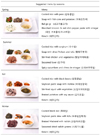1. Asano K, Yoon J, Yoon B. Appropriate size and dish combination of nutritional-balanced lunch boxes delivered to children under the government-funded meal service program in Korea. Korean J Community Nutr. 2009; 14(5):565–575.
2. Chang H, Ko E. The effectiveness of nutrition education provided by dietitians in child care centers. Korean J Community Nutr. 2007; 12(3):299–309.
3. Child Welfare Act 2006, Act No.7591, Partial Amendment Jul. 13, 2005. Article 16. Kinds of the child welfare facilities, Amended by Act No. 7143, Jan. 29, 2004. (Jan. 14, 2006).
4. Cho HS. A study on the actual condition for portion control of meal served by elementary school foodservice operation. Korean J Food Nutr. 1998; 11(1):54–60.
5. Cho HS. A study on the development of properly portioned meal sizes in the industry foodservice. Korean J Food Nutr. 1999; 12(1):26–32.
6. Choi MK, Lee HS, Kim SB, Kim SN, Kim SY, Kim MH. Establishment of one portion size of foods frequently consumed by Korean children aged 6-11 using 2005 Korea National Health and Nutrition Examination Survey and its comparison with adults. Korean J Community Nutr. 2010; 15(5):625–635.
7. Chung M, Lee YM, Lee KW. A study on the nutritional evaluation and food service managements of snacks in early childhood education institute. J Korean Home Econ Assoc. 2000; 38(4):99–113.
8. Fisher JO, Kral TV. Super-size me: portion size effects on young children's eating. Physiol Behav. 2008; 94(1):39–47.
9. Fisher JO, Liu Y, Birch LL, Rolls BJ. Effects of portion size and energy density on young children's intake at a meal. Am J Clin Nutr. 2007; 86(1):174–179.
10. Hwang JK, Lim JK, Shin YJ, Choi Y, Kim MS, Park YS, Kim SA. Evaluation report of community child centers in 2009. Report of Ministry of Health and Welfare in Korea. Seoul: Program Evaluation Support Group for Community Child Centers;2009.
11. Kim HY, Kim CM, Ko SH. A study on the actual condition for portion control of meal served by food service operation. Korean J Diet Cult. 1997; 12(1):79–86.
12. Kim MS, Kim HR, Cho AJ, Lee HW, Hong M, Kim HJ. Status on foodservice program for low-income children. Report of National Human Rights Commission of Korea. Seoul: National Human Rights Commission of Korea;2007.
13. Kwon S. Development and evaluation of the support model for foodservice management of community child centers in Korea. Seoul National University;2011. 37–87. Dissertation.
14. Kwon S, Lee K, Yoon J. Diet of children under the government-funded meal support program in Korea. Nutr Res Pract. 2010; 4(6):515–521.
15. Lee Y, Oh YJ. A study on the meal portion size of kindergarten. Korean J Nutr. 2007; 40(1):89–96.
16. Lee YJ, Chang KJ. Preliminary study on the establishment of proper portion using consumed size and food preference of frequently served meals in the elementary school lunch program in Inchon: I. a study on food preference of frequently servedmeals in the elementary school. J Korean Diet Assoc. 1998; 4(2):123–131.
17. Lee YJ, Chang KJ. Preliminary study on the establishment of proper portion using consumed size and food preference of frequently served meals in the elementary school lunch program in Inchon: II. a study on the consumption size of frequentlyserved meals in the elementary. J Korean Diet Assoc. 1998; 4(2):132–144.
18. Ministry of Health and Welfare, Headquarters for Community Child Center. Report of current status of community child centers in Korea (2013. 06). Seoul: Headquarters for Community Child Center;2013.
19. Ramsay SA, Branen LJ, Johnson SL. How much is enough? Tablespoon per year of age approach meets nutrition needs for children. Appetite. 2012; 58:163–167.
20. Shim JE, Yoon J, Lee K, Kwon S. Evaluation of dietary intake of Korean school-aged children from low-income families by comparing with the Korean food guide: analysis of the data from the 2001 National Health and Nutrition Survey. Korean J Nutr. 2009; 42(8):691–701.
21. Son JH, Chyun JH. Comparative study of satisfaction level on hospital meal size and actual intake rate between elderly and middle age patients. Korean J Food Cult. 2002; 17(5):619–628.
22. The Korean Nutiriton Society. Dietary reference intakes for Koreans. 1st revision. Seoul: The Korean Nutiriton Society;2010. p. 524–547.
23. Yoon J. Study on safety management in food service for children from low income families. Report of the Ministry of Food and Drug Safety in Korea. Cheongju: Ministry of Food and Drug Safety;2010.







 PDF
PDF ePub
ePub Citation
Citation Print
Print






 XML Download
XML Download